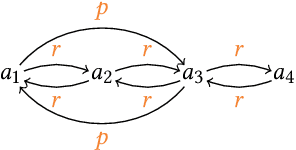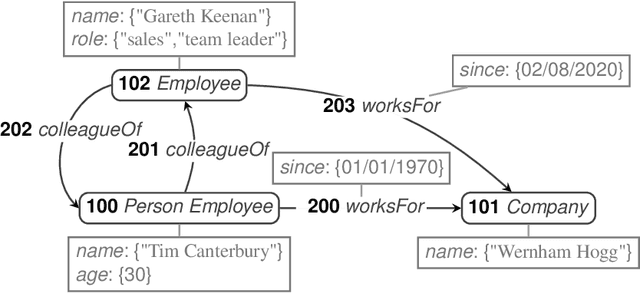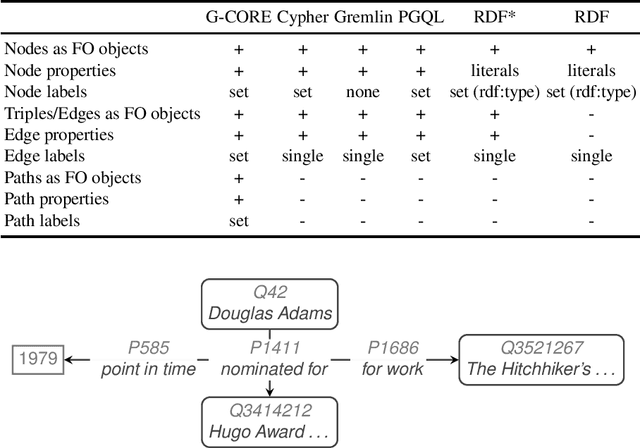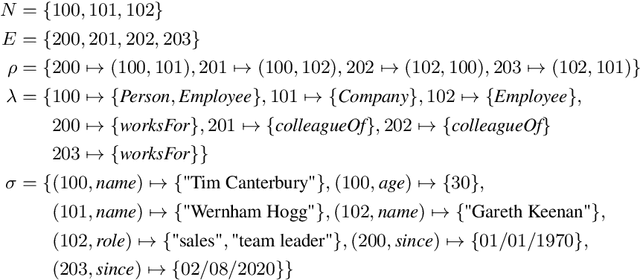Philipp Seifer
eSPARQL: Representing and Reconciling Agnostic and Atheistic Beliefs in RDF-star Knowledge Graphs
Aug 01, 2024Abstract:Over the past few years, we have seen the emergence of large knowledge graphs combining information from multiple sources. Sometimes, this information is provided in the form of assertions about other assertions, defining contexts where assertions are valid. A recent extension to RDF which admits statements over statements, called RDF-star, is in revision to become a W3C standard. However, there is no proposal for a semantics of these RDF-star statements nor a built-in facility to operate over them. In this paper, we propose a query language for epistemic RDF-star metadata based on a four-valued logic, called eSPARQL. Our proposed query language extends SPARQL-star, the query language for RDF-star, with a new type of FROM clause to facilitate operating with multiple and sometimes conflicting beliefs. We show that the proposed query language can express four use case queries, including the following features: (i) querying the belief of an individual, (ii) the aggregating of beliefs, (iii) querying who is conflicting with somebody, and (iv) beliefs about beliefs (i.e., nesting of beliefs).
From Shapes to Shapes: Inferring SHACL Shapes for Results of SPARQL CONSTRUCT Queries
Feb 13, 2024



Abstract:SPARQL CONSTRUCT queries allow for the specification of data processing pipelines that transform given input graphs into new output graphs. It is now common to constrain graphs through SHACL shapes allowing users to understand which data they can expect and which not. However, it becomes challenging to understand what graph data can be expected at the end of a data processing pipeline without knowing the particular input data: Shape constraints on the input graph may affect the output graph, but may no longer apply literally, and new shapes may be imposed by the query template. In this paper, we study the derivation of shape constraints that hold on all possible output graphs of a given SPARQL CONSTRUCT query. We assume that the SPARQL CONSTRUCT query is fixed, e.g., being part of a program, whereas the input graphs adhere to input shape constraints but may otherwise vary over time and, thus, are mostly unknown. We study a fragment of SPARQL CONSTRUCT queries (SCCQ) and a fragment of SHACL (Simple SHACL). We formally define the problem of deriving the most restrictive set of Simple SHACL shapes that constrain the results from evaluating a SCCQ over any input graph restricted by a given set of Simple SHACL shapes. We propose and implement an algorithm that statically analyses input SHACL shapes and CONSTRUCT queries and prove its soundness and complexity.
ProGS: Property Graph Shapes Language (Extended Version)
Jul 12, 2021



Abstract:Property graphs constitute data models for representing knowledge graphs. They allow for the convenient representation of facts, including facts about facts, represented by triples in subject or object position of other triples. Knowledge graphs such as Wikidata are created by a diversity of contributors and a range of sources leaving them prone to two types of errors. The first type of error, falsity of facts, is addressed by property graphs through the representation of provenance and validity, making triples occur as first-order objects in subject position of metadata triples. The second type of error, violation of domain constraints, has not been addressed with regard to property graphs so far. In RDF representations, this error can be addressed by shape languages such as SHACL or ShEx, which allow for checking whether graphs are valid with respect to a set of domain constraints. Borrowing ideas from the syntax and semantics definitions of SHACL, we design a shape language for property graphs, ProGS, which allows for formulating shape constraints on property graphs including their specific constructs, such as edges with identities and key-value annotations to both nodes and edges. We define a formal semantics of ProGS, investigate the resulting complexity of validating property graphs against sets of ProGS shapes, compare with corresponding results for SHACL, and implement a prototypical validator that utilizes answer set programming.
 Add to Chrome
Add to Chrome Add to Firefox
Add to Firefox Add to Edge
Add to Edge